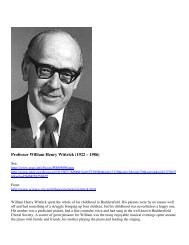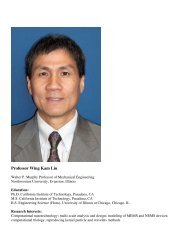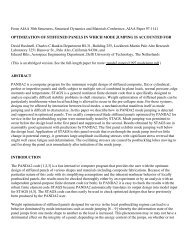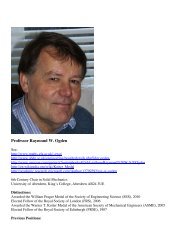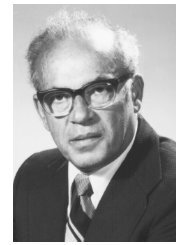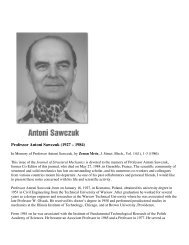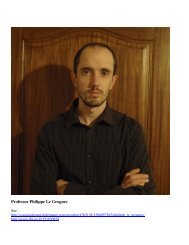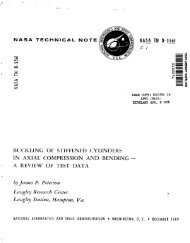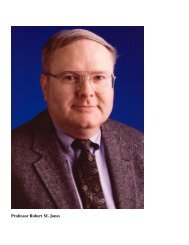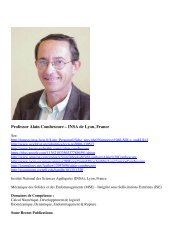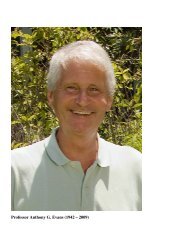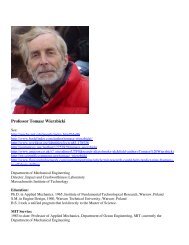Professor Carlos A. Brebbia - Shellbuckling.com
Professor Carlos A. Brebbia - Shellbuckling.com
Professor Carlos A. Brebbia - Shellbuckling.com
You also want an ePaper? Increase the reach of your titles
YUMPU automatically turns print PDFs into web optimized ePapers that Google loves.
<strong>Professor</strong> <strong>Carlos</strong> A. <strong>Brebbia</strong>BIOGRAPHY:<strong>Professor</strong> <strong>Carlos</strong> <strong>Brebbia</strong> is the Director of the Wessex Institute of Technology. He was born in Argentinawhere he <strong>com</strong>pleted his first engineering degree. He spent two stimulating years after graduation as part of asmall team setting up an Institute of Applied Mechanics. Following this, he registered at SouthamptonUniversity in England for a high degree, arranging to carry out his research partly at MIT.After obtaining his PhD at Southampton, he worked at a UK Research Laboratory before taking an academicappointment at Southampton University where he rose from Lecturer to Senior Lecturer and Reader. During histime at Southampton he took leave to be<strong>com</strong>e Visiting <strong>Professor</strong> at many other universities, includingPrinceton.After having been appointed full <strong>Professor</strong> of Engineering at the University of California, Irvine, he decided toreturn to the UK to set up the Wessex Institute in the New Forest.<strong>Professor</strong> <strong>Brebbia</strong> is renowned throughout the world as the originator of the Boundary Element Method, atechnique that continues to generate important research work at the Wessex Institute. He has written numerousscientific papers and is author or co-author of 14 technical books and editor or co-editor of more than 400volumes. He has also written two other non technical books, ie "The New Forest. A Personal View" and"Patagonia, the forgotten land".
He is Editor-in-Chief of the International Journal of Engineering Analysis with Boundary Elements and, morerecently, his interest in ecological and environmental topics has led him to be<strong>com</strong>e co-editor of the newInternational Journal of Ecodynamics and International Journal of Sustainable Development and Planning.<strong>Carlos</strong>' interests span from the analysis of advanced structures such as shells to the modelling of environmentalproblems, dealing with a wide variety of methodologies. His most recent efforts have been concentrated on thedevelopment of Wessex Institute as an international centre of excellence.CURRENT POSITIONS:Director of Wessex Institute of Technology, New Forest (The Institute is validated by the University of Wales)Chairman of Computational Mechanics International Group of <strong>com</strong>panies<strong>Professor</strong> of Computational Engineering, University of PortsmouthSPECIAL HONOURS:Medaille de la Ville de Paris, Echelon Argent.Medaille of the Masonnet Foundation, University of Liege, Belgium.Visiting <strong>Professor</strong> for Special Lecture Series at the Free University of Brussels, Belgium.Visiting <strong>Professor</strong> for Special Lecture Series at the University of Florence, Italy.Fellow of the Institution of Mechanical Engineers (FImechE)Founding President - ASCE-UK Chapter.Honorary PhD at University of Bucharest.Freedom of the City of London and Liveryman to the Worshipful Company of Scientific Instrument Makers.Permanent Member of the Prize Committee for the Prigogine Medal.Member of the Prize Council of the Prince Sultan Bin Abdulaziz International Prize for Water.Fellow of the Royal Society of Arts (Royal Society for the encouragement of Arts, Manufactures andCommerce).JOURNALS & SERIES PUBLICATIONS:<strong>Professor</strong> <strong>Brebbia</strong> is member of the Board of numerous book series and has launched 10 international journals,some of which have been assigned to Elsevier. At present he is an active main Editor or Co-Editor of thefollowing journals:1. Editor in Chief and Founder of the International Journal on "Engineering Analysis with Boundary Elements"published by Elsevier.2. Co-Editor of the "International Journal of Ecodynamics".3. Co-Editor of the "International Journal of Sustainable Development and Planning".4. Co-Editor of the "International Journal of Design and Nature".5. Main Editor of the Transactions of Wessex Institute (which includes sections on Ecology and theEnvironment).TRAINING FILMS:"Finite Elements". The film was produced by Rutherford Computing Laboratory with <strong>com</strong>puter animationsprovided by <strong>Professor</strong> <strong>Brebbia</strong>.
"Boundary Elements". This film was produced by <strong>Professor</strong> <strong>Brebbia</strong> demonstrating the technique hedeveloped.PAPERS:More than 300 papers published in scientific journals and conference proceedings.MAIN INTERESTS:Computational Methods in Engineering, including his technique of Boundary Elements; EnvironmentalSimulation; Ecological Modelling; and Sustainable Development.BOOKS WRITTEN:- TECHNICAL BOOKS - 14 technical books produced by different Publishers - among them McGraw Hill,Elsevier, Springer Verlag, Computational Mechanics Publications, WIT Press - and translated into severalmajor languages.- NON-TECHNICAL BOOKS"The New Forest. A Personal View". Fourth Edition. WIT Press, Southampton and Boston, 2006."Patagonia. The Forgotten Land. From Magellan to Peron". WIT Press, Southampton and Boston, 2007.- EDITED BOOKSMore than 400 books edited.SELECTED PUBLICATIONS:J. Connor and C. <strong>Brebbia</strong>, “Stiffness matrix for shallow rectangular shell element”, ASCE Journal of theEngineering Mechanics Division, No. EM5, October 1967C. A. <strong>Brebbia</strong> and J. M. Deb Nath (Civil Engineering Department, University of Southampton), “A <strong>com</strong>parisonof recent shallow shell finite-element analyses”, International Journal of Mechanical Sciences, Vol. 12, No. 10,October 1970, pp. 849-857, doi:10.1016/0020-7403(70)90022-6ABSTRACT: Recent advances in the analysis of shallow shells by finite-element technique are reviewed andresults obtained using different stiffness matrices <strong>com</strong>pared. The question of including rigid body modes in theprescribed displacement field is discussed. It is found that the constant strain condition, other than the trivialone—i.e. rigid body modes—cannot be satisfied in the case of curved plates and shells.C.A. <strong>Brebbia</strong> and J. Connor, “Geometrically nonlinear finite element analysis”, Proc. ASCE, Vol. 95, No. EM2,1971, pp. 463-483Tottenham, H. and <strong>Brebbia</strong>, C. (ed.): Finite Element Techniques in Structural Mechanics, Stress AnalysisPublishers, Southampton 1971



